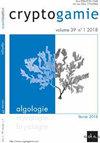Diversity of Silica-scaled Chrysophytes in High-altitude Alpine Sites (North Tyrol, Austria) Including a Description of Mallomonas pechlaneri sp. nov.
IF 1.5
4区 生物学
Q3 MARINE & FRESHWATER BIOLOGY
引用次数: 10
Abstract
Abstract To expand on the biodiversity study of the eastern Alpine region of North Tyrol, we investigated silica-scaled chrysophyte flora of unexplored high-altitude Alpine sites. We concentrated mostly on lakes that were 1000–2500 m above sea level; some of them were still partly ice covered. Overall, 27 taxa were recorded at 12 sites, despite 21 sites being sampled altogether. In general, the sites were oligotrophic and species poor. Due to a restricted data set, an extensive analysis was not possible. However, altitude and pH were found to be important variables for explaining species distribution. We described the new species Mallomonas pechlaneri from two of the sampled sites. Mallomonas pechlaneri most closely resembles Mallomonas striata var. striata and M. striata var. serrata; these three taxa are clearly distinguished by bristle morphology and scale shape. The bristles of M. pechlaneri terminate in a bifurcated tip consisting of unequal diverging branches. Scale shape was captured my means of landmark-based geometric morphometries (GM) and evaluated using multivariate statistical analyses. GM methods proved to be an efficient tool to be employed in chrysophycean taxonomy.奥地利北蒂罗尔高海拔高山遗址二氧化硅鳞片苔藓植物的多样性——包括绿单胞菌的描述。
摘要:为了扩大对北蒂罗尔东部高寒地区生物多样性的研究,我们对未开发的高海拔高寒地区的硅鳞苔藓植物区系进行了调查。我们主要集中在海拔1000-2500米的湖泊;其中一些还部分被冰覆盖着。总体而言,在12个地点记录了27个分类群,尽管总共采样了21个地点。总的来说,这些地点是少营养和物种贫乏的。由于数据集有限,无法进行广泛的分析。海拔和pH值是解释物种分布的重要变量。我们从两个采样点描述了新物种绿单胞菌。pechlaneri绿单胞菌与纹状绿单胞菌变种和锯齿纹状绿单胞菌最为相似;这三个分类群在刚毛形态和鳞片形状上有明显的区别。毛刺的刚毛终止于由不等分叉的分支组成的分叉的尖端。尺度形状是通过基于地标的几何形态测量(GM)方法捕获的,并使用多元统计分析进行评估。转基因方法是一种有效的软体动物分类方法。
本文章由计算机程序翻译,如有差异,请以英文原文为准。
求助全文
约1分钟内获得全文
求助全文
来源期刊

Cryptogamie Algologie
生物-海洋与淡水生物学
CiteScore
2.60
自引率
7.70%
发文量
11
审稿时长
>12 weeks
期刊介绍:
Cryptogamie is a fast-track and peer-reviewed journal of international scope publishing in English only. It accepts original papers and review articles on the taxonomy, biology and ecology of all cryptogams. An issue of Cryptogamie may be devoted to a single topic, under the responsibility of guest editor(s). All articles published in Cryptogamie are compliant with the different nomenclatural codes. A copyright assignment will be signed by the authors before publication.
Cryptogamie, Algologie accepts articles on systematics as well as ecology and evolution of any kind of algae (including Cyanobacteria).
 求助内容:
求助内容: 应助结果提醒方式:
应助结果提醒方式:


